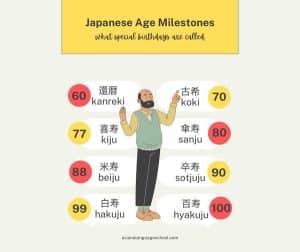Japanese Age Milestones: From Sichi-Go-San To Hyakuju
In Japan, age milestones hold great cultural and traditional significance. These milestones are often marked with celebrations, rituals, and rites of passage that reflect the importance of growth, maturity, and community. Some of these customs are centuries old, while others have evolved in modern times. Here is a look at some of the key age milestones in Japan. You can learn Japanese online by learning the special birthday terms in this article.
- Shichi-Go-San (7-5-3)
One of the most well-known age milestones in Japan is Shichi-Go-San, which celebrates children at the ages of 3, 5, and 7. Traditionally, these ages were seen as important for a child’s physical and spiritual development.
- At age 3, girls and boys celebrate their first visit to a shrine for a blessing. For girls, it marks the age when they begin growing their hair, and for boys, it is when they first wear formal clothes such as the hakama (traditional trousers).
- At age 5, boys celebrate by wearing a hakama and receiving a ritual blessing, symbolizing their entry into manhood. This marks the traditional age when boys were considered ready for formal education and societal participation.
- At age 7, girls are dressed in more elaborate kimono and are blessed at the shrine, celebrating their transition into young adulthood.
The celebration involves family gatherings, visits to shrines, and the offering of special prayers for the children’s health and future prosperity. Parents often buy the children traditional outfits and sometimes present them with a special “chitose-ame” (thousand-year candy), a sweet treat symbolizing good health and longevity.
- Seijin Shiki (Coming-of-Age Day)
Another important milestone is Seijin Shiki, or Coming-of-Age Day, which takes place on the second Monday of January each year. This celebration honors those who have reached the age of 20, marking the official transition from adolescence to adulthood.
- Age 20 is significant in Japan, as it is the legal age for voting, drinking, and other adult privileges. On this day, young adults celebrate by wearing formal attire, with women typically donning colorful kimonos and men wearing suits. Many participate in ceremonies held at local government offices, where speeches are made to inspire responsibility and social participation.
- The day is also marked by social gatherings, parties, and family celebrations, where young adults are congratulated by relatives and friends. It is seen as a rite of passage into the responsibilities of adulthood.
- Kanreki (60th Birthday)
In Japan, the Kanreki is a significant milestone celebrated at the age of 60. The 60th birthday marks the completion of one full cycle of the Chinese zodiac, which follows a 60-year cycle. This celebration symbolizes the renewal of life, as the individual is said to return to their “childhood” years, both in terms of age and spirit.
- For the celebration, the person often wears a red vest or clothing, symbolizing the return to the innocence and joy of childhood. This is because the color red is associated with protection and vitality in Japanese culture.
- The Kanreki is not just a celebration of longevity but also a time to honor the wisdom and experiences accumulated over the years. Family members and friends often gather to offer congratulations and blessings.
- Koki (70th Birthday)
The Koki or 70th birthday is another important milestone in Japanese culture. In some regions, the 70th birthday is marked by the giving of a special gift, often a piece of clothing or a red-and-white decoration, symbolizing the transition into the second phase of life. This celebration honors the elderly, acknowledging their wisdom, experience, and contributions to the family and community.
- Kiju (77th Birthday)
The Kiju (七十七) marks the 77th birthday, a milestone celebrated as a symbol of prosperity and good fortune. In Japan, 77 is considered a “lucky” number, representing a harmonious balance in life. It is viewed as a time to honor the person’s continued vitality and longevity. Traditionally, the Kiju celebration may involve family gatherings, and the individual may receive well-wishes for further health and happiness. The occasion is seen as an affirmation of the person’s successful navigation through the earlier years of their life.
- Sanju (80th Birthday)
The Sanju (八十) is the 80th birthday, which is an important milestone in Japanese culture. The celebration emphasizes the appreciation of longevity and the honor bestowed upon individuals who have reached this stage of life. At 80, people are often regarded as having accumulated vast life experience and wisdom. Sanju is often observed with family members who express their gratitude and respect. In some cases, gifts and special meals are given, symbolizing the joy of celebrating a long life filled with accomplishments.
- Beiju (88th Birthday)
The Beiju (米寿) marks the 88th birthday, an especially revered milestone in Japan. The number 88 is associated with the character for rice (米), which is seen as a symbol of prosperity and abundance. This milestone is celebrated as a significant event in a person’s life, acknowledging their good health and longevity. During Beiju, the honoree often wears a special yellow or golden-colored vest, representing good fortune. Families and friends gather to honor the individual, and it is common to offer symbolic gifts or celebrate with a feast.
- Sotjuju (90th Birthday)
- Hakuju (99th Birthday)
The Hakuju (白寿) is the 99th birthday, a highly respected and joyous occasion in Japan. The term “Hakuju” is derived from the kanji for “white” (白), as it is said that when a person turns 99, they are nearly at the symbolic age of 100. It is a time to celebrate nearly a full century of life, filled with experiences, wisdom, and memories. The celebration of Hakuju is typically marked by deep gratitude, family gatherings, and expressions of love and respect. The individual is often honored with heartfelt wishes for continued health and happiness.
- Hyakuju (100th Birthday)
The Hyakuju (百寿) represents the incredible milestone of turning 100 years old. In Japanese culture, reaching 100 is seen as an extraordinary achievement and is a cause for great celebration. The occasion is viewed with profound respect, and the individual’s long life is honored through ceremonies, gifts, and sometimes national recognition. In recent years, the government even sends congratulatory letters to centenarians to honor their longevity. The Hyakuju celebration often involves gatherings with family, friends, and community members, as well as prayers for further health and peace in the individual’s later years.
From the celebration of childhood milestones like Shichi-Go-San to the marking of adulthood with Seijin Shiki, the respect for aging, wisdom, and community ties is a significant part of Japanese life. These milestones serve not only as personal achievements but also as opportunities to reflect on one’s role within the family and society. In this way, Japan’s age-related rituals contribute to maintaining a deep respect for life’s stages and the bonds that tie generations together.
Sign up for Japanese language classes today to learn more about the Japanese language and culture!




